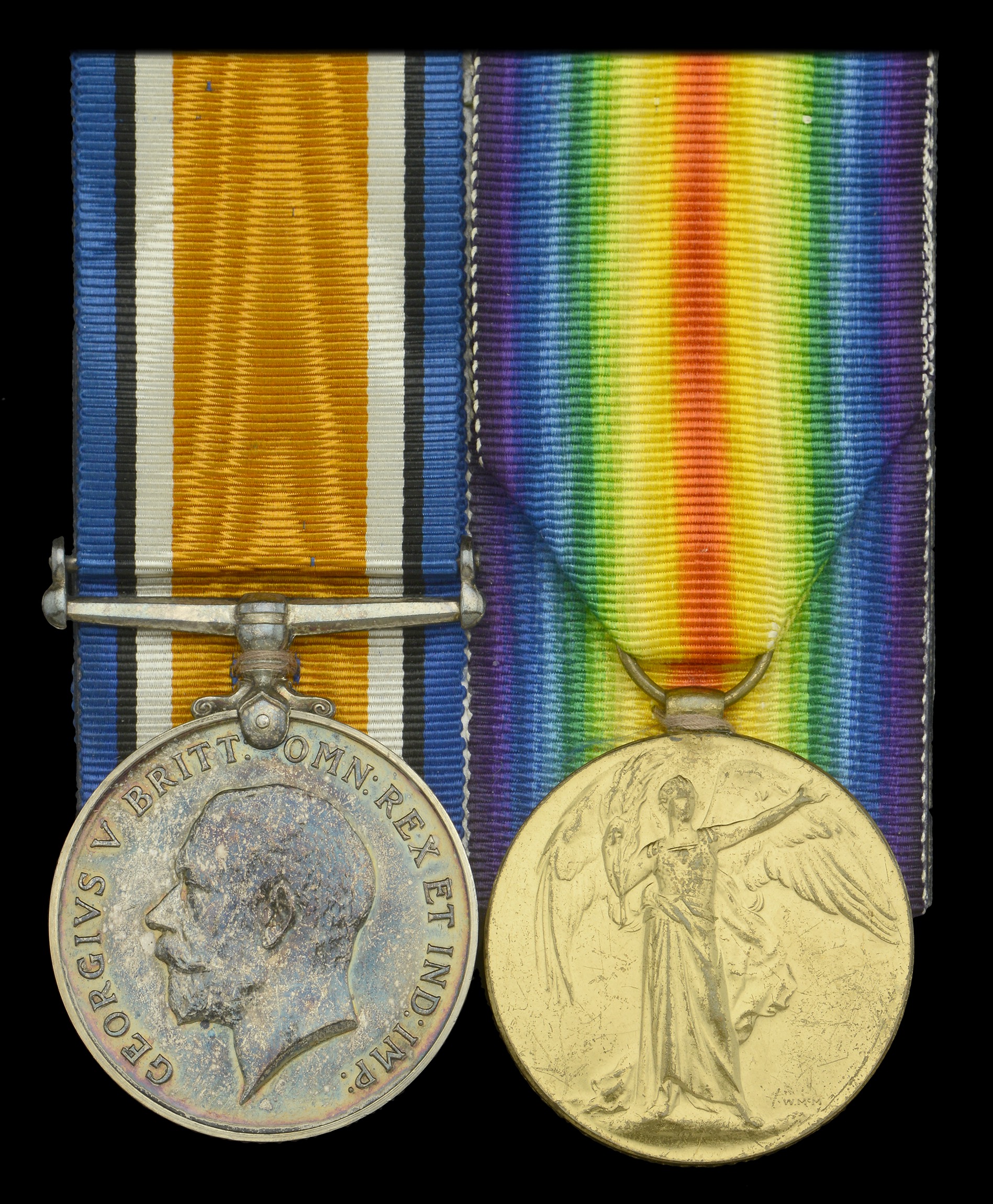A fine Great War ‘Italian theatre’ Sopwith Camel Pilot’s pair awarded to Captain J. Mackereth, Royal Flying Corps and Royal Air Force, who flew with 28 and 66 Squadrons - claiming 4 enemy aircraft shot down, 1 shared destroyed, and 2 Kite Balloons destroyed. Unlucky not to have been decorated, Mackereth was wounded in the leg by anti-aircraft fire whilst in the process of shooting down a Kite Balloon, 31 August 1918. Forced to crash land his aircraft, he was taken prisoner and interned in Bavaria for the remainder of the conflict. Having joined the service straight from school, he returned to education gaining a degree and a diploma in forestry from Oxford. Mackereth was employed as a Deputy Conservator in the Indian Forestry Service - and it was in this capacity that he was murdered by one of his recently dismissed staff at Moulmein, Burma in May 1933 British War and Victory Medals (Capt. J. Mackereth. R.A.F.) mounted for display, extremely fine (2) £800-£1,000 --- John Mackereth was born in Norwood, London in October 1898. He was educated at Dulwich College, 1910-17, and joined the Royal Flying Corps as a Second Lieutenant (on probation) straight from school in June 1917. Mackereth advanced to Flying Officer in August 1917, having carried out pilot training at 8 and 67 Training Squadrons. He was posted for operational flying to 28 Squadron (Sopwith Camels) briefly in France before transferring with the Squadron to Italy at the end of October 1917. The Squadron flew offensive patrols over the front in north-east Italy before the Austro-Hungarian Empire collapsed. Mackereth first success came when he shot down a Balloon, 19 May 1918: ‘On 19 May, Lt. J. Mackereth was leading a three strong Camel patrol over Vittorio at 11,000ft. Below them he saw a kit balloon over Piave di Soligo. Leaving his patrol Mackereth dived to intercept and relying solely on his tracers he made six attacks before the KB burst into flames, its observer taking to his parachute. He rounded off his attack by strafing transport and infantry. It later became a field day for Lt. A. G. Cooper who notched two D.V.’s down in flames and a third out of control.’ (Article by D. Neate that appeared in Cross & Cockade Vol. 31, 2000, refers) Mackereth’s aircraft suffered ant-aircraft fire damage whilst he was carrying out an offensive patrol four days later. He shot down an Albatros DV in flames over Susegana-Sarano, 1 June 1918, and added another 5km west of Feltre, 15 June 1918. The Combat Report gives the following for the latter date: ‘While on Offensive Patrol Lt. Mackereth saw 7 Albatross D.5’s at 10,000 ft at 7.10am over Fonzaso. The E.A. dived on the formation. Lt. White attacked one and after a short combat the E.A. was shot down, breaking to pieces in the air... Again at 8am the Patrol saw 6 D.5’s at 11,000 ft over Feltre. Diving into them Capt. Hallonquist attack one... Lt. Mackereth also attacked one of the others and put him out of control with a good burst of fire...’ Mackereth added to his score on 30 June 1918: ‘The last day of June saw Capt. Hallonquist and Lt. J. Mackereth on patrol, ignoring the fact that there were only two of them, they attacked five D.V.’s escorting an Aviatik between Luciana and the Astico valley. Attacking, Mackereth sent his opponent down vertically (seen crashing by a member of 45 Squadron) and Hallonquist drove his down out of control (witnessed by a 34 Squadron crew).’ (Article by D. Neate that appeared in Cross & Cockade Vol. 31, 2000, refers) Mackereth shot down his fourth Albatross DV, over Pederiva, 7 July 1918, and Shared a Brandenburg 2 seater with Captain J. E. Hallonquist over Pordenone, 13 July 1918. Mackereth advanced to Temporary Captain in July 1918, and transferred to 66 Squadron who were also flying Camels and based in Italy. He was wounded in the leg by anti-aircraft fire whilst shooting down a Balloon, near Conegliano, 31 August 1918. Mackereth crash landed his aircraft and was taken prisoner of war: ‘[He] was for a long time a prisoner of war in Bavaria. He resigned his commission in 1920 and went up to Exeter College, Oxford, where he took his degree and the diploma in forestry. He joined the Indian Forest Service on December 31, 1924, and was posted to Burma. He was promoted a deputy conservator in March, 1929, and was stationed at Rangoon. He had been sent to Moulmein to carry out reorganisation... was shot dead at Moulmein last Friday [May 1933] by one of his servants [whom he had just let go from employment] with his own sporting gun.’ (Obituary refers) Sold with extensive copied research, including relevant Squadron Record Books and Combat Reports, and 2 photographic images of recipient whilst with 28 Squadron.





